The Remote Valve Tissue Expanders Market is estimated to be valued at USD 782.7 billion in 2025 and is projected to reach USD 1374.8 billion by 2035, registering a compound annual growth rate (CAGR) of 5.8% over the forecast period.
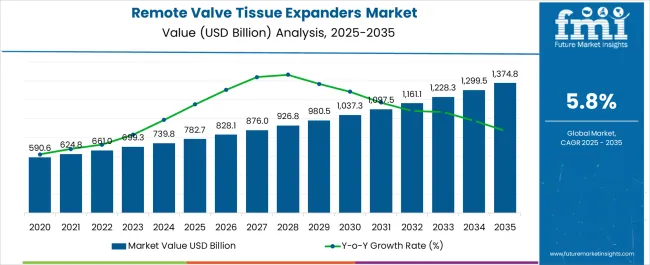
| Metric | Value |
|---|---|
| Remote Valve Tissue Expanders Market Estimated Value in (2025 E) | USD 782.7 billion |
| Remote Valve Tissue Expanders Market Forecast Value in (2035 F) | USD 1374.8 billion |
| Forecast CAGR (2025 to 2035) | 5.8% |
The remote valve tissue expanders market is gaining traction as demand rises for advanced reconstructive procedures, particularly in breast reconstruction and craniofacial surgeries. Growing awareness of minimally invasive options and technological improvements in expander designs are driving adoption among both patients and healthcare providers.
The ability of remote valve systems to offer controlled expansion without frequent clinical visits has enhanced patient comfort and reduced procedural complexities. Hospitals and specialized surgical centers are increasingly incorporating these devices to improve outcomes and patient satisfaction.
Advances in biomaterials, integration with imaging technologies, and enhanced safety mechanisms are strengthening clinical confidence. The market outlook remains positive as rising prevalence of breast cancer, trauma related deformities, and congenital anomalies continues to increase the need for efficient tissue expansion solutions.
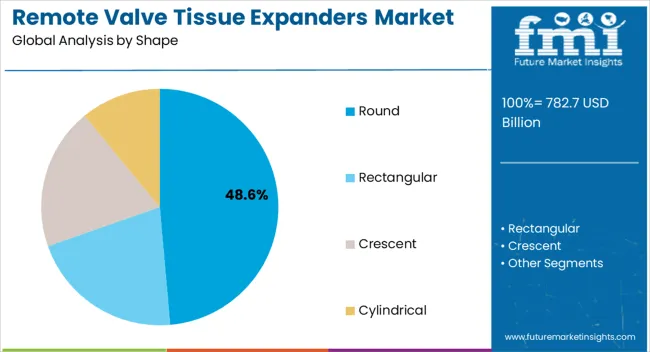
The round shape segment is expected to contribute 48.60% of the overall market by 2025, making it the leading shape category. This dominance is supported by its aesthetic advantages in creating natural contours during reconstructive procedures and its ease of surgical placement.
Surgeons prefer round expanders due to predictable outcomes, uniform stretching, and reduced risk of complications during gradual expansion. The design has been widely adopted in both breast reconstruction and cosmetic procedures, reinforcing its strong market presence.
Patient satisfaction associated with improved post operative appearance has also contributed to higher demand for round shaped expanders, consolidating their leadership within this category.
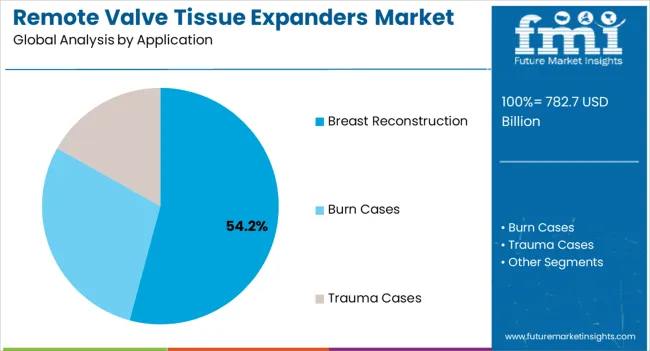
The breast reconstruction application segment is projected to account for 54.20% of total revenue in 2025, positioning it as the most prominent application area. This growth is being fueled by the rising incidence of breast cancer and the subsequent increase in mastectomy procedures, which necessitate reconstructive interventions.
Remote valve tissue expanders are particularly valued for enabling staged reconstruction with reduced clinical visits, thereby enhancing patient convenience. Supportive reimbursement frameworks, growing awareness of post mastectomy reconstruction, and ongoing clinical innovations have further encouraged adoption.
With reconstructive outcomes becoming an integral part of cancer care, this application remains the strongest growth driver in the market.
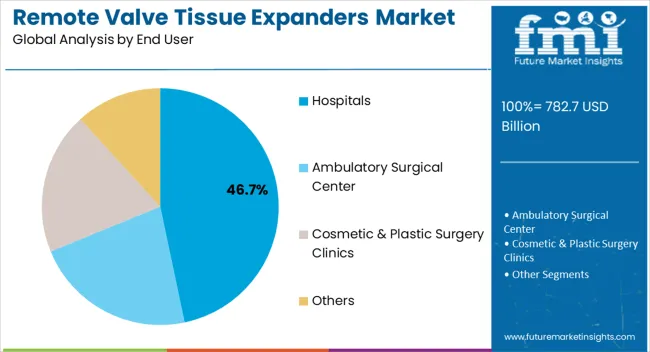
The hospitals segment is expected to hold 46.70% of total market share by 2025, making it the leading end user category. Hospitals remain the primary centers for complex reconstructive surgeries, offering the infrastructure, expertise, and post operative care necessary for tissue expansion procedures.
The availability of multidisciplinary teams and advanced surgical facilities has supported widespread adoption of remote valve tissue expanders in these settings. Increasing patient referrals, coupled with the ability to handle higher surgical volumes, has reinforced the dominance of hospitals.
Their role in driving clinical best practices and adopting advanced technologies continues to secure their leadership within the end user segment.
From 2020 to 2025, the global remote valve tissue expander market experienced a CAGR of 5.6%, reaching a market size of USD 782.7 million in 2025.
From 2020 to 2025, the global remote valve tissue expander market industry witnessed steady growth due to the increasing demand for reconstructive surgery.
Lung cancer is one of the top causes of cancer mortality globally. Reconstructive operations, such as breast reconstruction following mastectomy, are in high demand. As a result, the need for tissue expanders as a key technique of tissue repair has increased.
Tissue expander design, materials, and remote control capabilities have all improved over the years. These advancements have improved patient outcomes while also broadening the uses of tissue expanders.
Future Forecast for Remote Valve Tissue Expanders Market Industry:
Looking ahead, the global remote valve tissue expander market industry is expected to rise at a CAGR of 6.1% from 2025 to 2035. During the forecast period, the market size is expected to reach USD 1374.8 billion by 2035.
The remote valve tissue expander market industry is expected to continue its growth trajectory from 2025 to 2035. The popularity of less invasive surgeries is growing. Tissue expander technology improvements in the future may focus on producing smaller and less intrusive devices, minimizing patient suffering and recovery time.
Personalised medicine is fast progressing. Tissue expanders that may be tailored to particular patient demands, such as size, shape, and remote control choices, could become more common in the future, increasing market expansion.
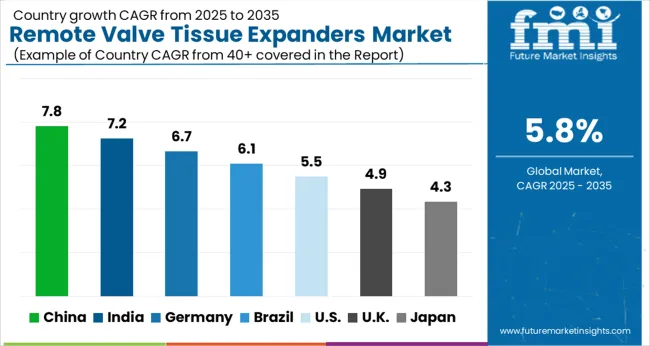
| Country | The United States |
|---|---|
| Market Size (USD Million) by End of Forecast Period (2035) | USD 1374.8 million |
| CAGR % 2025 to End of Forecast (2035) | 6.0% |
The remote valve tissue expander market industry in the United States is expected to reach a market size of USD 1374.8 million by 2035, expanding at a CAGR of 6.0%.
Breast reconstruction operations, including tissue expansion, are becoming increasingly frequent as a result of variables such as increased breast cancer awareness and availability to reconstructive surgery. According to Breastcancer.org, more than 107,000 breast reconstruction surgeries were performed in the United States in 2020.
The increasing demand for breast reconstruction operations necessitates the use of remote valve tissue expanders, which are routinely employed in the first stage of the reconstruction process.
| Country | The United Kingdom |
|---|---|
| Market Size (USD Million) by End of Forecast Period (2035) | USD 34.1 million |
| CAGR % 2025 to End of Forecast (2035) | 4.1% |
The remote valve tissue expander market industry in the United Kingdom is expected to reach a market value of USD 34.1 million, expanding at a CAGR of 4.1% during the forecast period.
The regulatory rules and recommendations established by agencies such as the Medicines and Healthcare products Regulatory Agency (MHRA) can have a considerable influence on the removal valve tissue expander industry in the United Kingdom.
Product availability and market access might be hampered by stringent rules and approval processes. Furthermore, the UK's ageing population may lead to a rise in demand for tissue expanders.
| Country | China |
|---|---|
| Market Size (USD Million) by End of Forecast Period (2035) | USD 42.4 million |
| CAGR % 2025 to End of Forecast (2035) | 7.1% |
The remote valve tissue expander market industry in China is anticipated to reach a market size of USD 42.4 million, moving at a CAGR of 7.1% during the forecast period. The remote valve tissue expander market industry in China is expected to grow prominently due to the increasing medical tourism.
Due to its excellent healthcare facilities and cheaper treatment prices, China has become a popular destination for medical tourism. This may draw patients from other nations seeking breast reconstruction surgeries, increasing demand for removal valve tissue expanders.
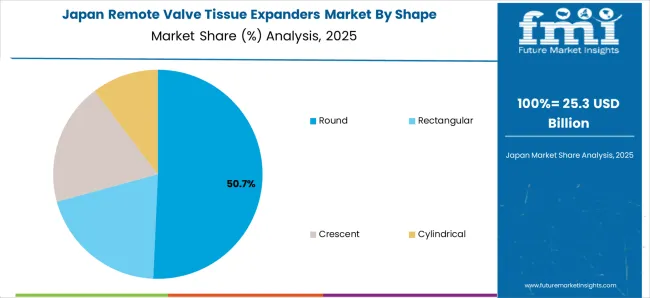
| Country | Japan |
|---|---|
| Market Size (USD Million) by End of Forecast Period (2035) | USD 21.9 million |
| CAGR % 2025 to End of Forecast (2035) | 4.8% |
The remote valve tissue expander market industry in Japan is estimated to reach a market size of USD 21.9 million by 2035, thriving at a CAGR of 4.8%. The market in Japan is predicted to grow because of its reconstructive surgery culture.
Japan has a robust reconstructive surgery culture, which includes breast reconstruction. This cultural tendency, along with rising breast cancer awareness, may drive demand for removing valve tissue expanders in the country.
| Country | South Korea |
|---|---|
| Market Size (USD Million) by End of Forecast Period (2035) | USD 47.8 million |
| CAGR % 2025 to End of Forecast (2035) | 6.5% |
The remote valve tissue expander market industry in South Korea is expected to reach a market size of USD 47.8 million, expanding at a CAGR of 6.5% during the forecast period. South Korea is well-known for its technology breakthroughs and healthcare spending.
South Korea has an ageing population and a greater emphasis on healthcare. As a result, surgical treatments and post-surgical solutions such as tissue expanders are being prioritized. This may aid in the growth of the removal valve tissue expanders industry.
The cylindrical dominated the remote valve tissue expander market industry with a market share of 35.6% in 2025. Cylindrical expanders are widely used for the tissue expansion as this shape allows for uniform stretching and growth, resulting in a more natural and aesthetically pleasing outcome.
It ensures that the expanded tissue matches the surrounding anatomy accurately. These benefits associated with the cylindrical shape, the demand is rising.
The breast reconstruction is dominating the remote valve tissue expander market with the market share of 59.0% in 2025. The high frequency of breast cancer throughout the world accounts for the market's significant proportion of breast reconstruction. Breast reconstruction is most typically performed following breast cancer surgery to treat or prevent the disease.
Providers utilize it to shape breasts and replace damaged or missing tissue. This method can also be used to reestablish symmetry. This suggests that both breasts are designed to be the same size and shape.
The hospital is dominating the remote valve tissue expander market with the market share of 46.0% in 2025. Patients commonly visit hospitals for rapid and efficient care, as the need for specialist treatments grows, fueling the segment's growth.
Furthermore, due to the global increase in breast cancer prevalence and burn cases the more people are seeking treatment and care at hospitals.
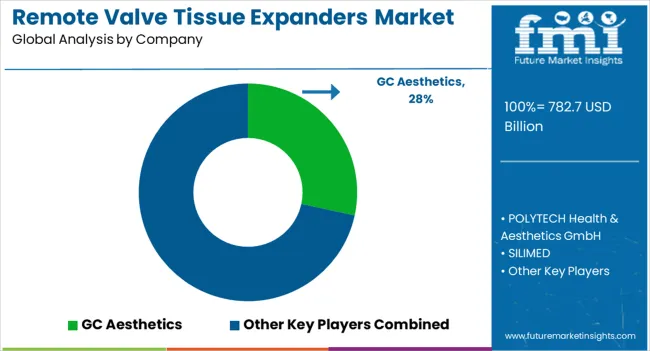
The remote valve tissue expanders sector is fiercely competitive, with many companies fighting for market dominance. To stay ahead of the competition in such a circumstance, essential players must employ smart techniques.
Key Strategies Used by the Participants
Product Innovation
Key players focus on developing and introducing innovative products to address unmet needs in the market. They invest in research and development to improve existing formulations, delivery systems, and enhance the efficacy and safety of the products
Strategic Partnerships and Collaborations
Key players often form strategic partnerships and collaborations with other companies, research institutes, or healthcare organizations, these partnerships allow for knowledge sharing, joint research and development efforts, and access to complementary technologies or expertise.
Expansion into Emerging Markets
Key players strive to expand their presence in different geographic regions to tap into new markets and reach a wider customer base. They may establish subsidiaries, distribution networks. Or strategic alliances in various countries to strengthen their market position.
Mergers and Acquisitions
Companies in the market may engage in mergers or acquisitions to consolidate their product portfolio, acquire new technologies, these strategic moves allow companies to enter new market segments, gain access to novel products or intellectual property, and achieve synergies in terms of research, manufacturing, or distributions.
Key Developments in the Remote Valve Tissue Expanders Market:
The global remote valve tissue expanders market is estimated to be valued at USD 782.7 billion in 2025.
The market size for the remote valve tissue expanders market is projected to reach USD 1,374.8 billion by 2035.
The remote valve tissue expanders market is expected to grow at a 5.8% CAGR between 2025 and 2035.
The key product types in remote valve tissue expanders market are round, rectangular, crescent and cylindrical.
In terms of application, breast reconstruction segment to command 54.2% share in the remote valve tissue expanders market in 2025.






Our Research Products

The "Full Research Suite" delivers actionable market intel, deep dives on markets or technologies, so clients act faster, cut risk, and unlock growth.

The Leaderboard benchmarks and ranks top vendors, classifying them as Established Leaders, Leading Challengers, or Disruptors & Challengers.

Locates where complements amplify value and substitutes erode it, forecasting net impact by horizon

We deliver granular, decision-grade intel: market sizing, 5-year forecasts, pricing, adoption, usage, revenue, and operational KPIs—plus competitor tracking, regulation, and value chains—across 60 countries broadly.

Spot the shifts before they hit your P&L. We track inflection points, adoption curves, pricing moves, and ecosystem plays to show where demand is heading, why it is changing, and what to do next across high-growth markets and disruptive tech

Real-time reads of user behavior. We track shifting priorities, perceptions of today’s and next-gen services, and provider experience, then pace how fast tech moves from trial to adoption, blending buyer, consumer, and channel inputs with social signals (#WhySwitch, #UX).

Partner with our analyst team to build a custom report designed around your business priorities. From analysing market trends to assessing competitors or crafting bespoke datasets, we tailor insights to your needs.
Supplier Intelligence
Discovery & Profiling
Capacity & Footprint
Performance & Risk
Compliance & Governance
Commercial Readiness
Who Supplies Whom
Scorecards & Shortlists
Playbooks & Docs
Category Intelligence
Definition & Scope
Demand & Use Cases
Cost Drivers
Market Structure
Supply Chain Map
Trade & Policy
Operating Norms
Deliverables
Buyer Intelligence
Account Basics
Spend & Scope
Procurement Model
Vendor Requirements
Terms & Policies
Entry Strategy
Pain Points & Triggers
Outputs
Pricing Analysis
Benchmarks
Trends
Should-Cost
Indexation
Landed Cost
Commercial Terms
Deliverables
Brand Analysis
Positioning & Value Prop
Share & Presence
Customer Evidence
Go-to-Market
Digital & Reputation
Compliance & Trust
KPIs & Gaps
Outputs
Full Research Suite comprises of:
Market outlook & trends analysis
Interviews & case studies
Strategic recommendations
Vendor profiles & capabilities analysis
5-year forecasts
8 regions and 60+ country-level data splits
Market segment data splits
12 months of continuous data updates
DELIVERED AS:
PDF EXCEL ONLINE
Remote ICU Monitoring System Market Size and Share Forecast Outlook 2025 to 2035
Remote Lockout Tool Market Size and Share Forecast Outlook 2025 to 2035
Remote Desktop Software Market Forecast and Outlook 2025 to 2035
Remote Patient Monitoring Devices Market Size and Share Forecast Outlook 2025 to 2035
Remote Assist Headrest Market Size and Share Forecast Outlook 2025 to 2035
Remote Endarterectomy Devices Market Size and Share Forecast Outlook 2025 to 2035
Remote Electrocardiogram Monitoring Market Size and Share Forecast Outlook 2025 to 2035
Remote Patient Monitoring System Market Size and Share Forecast Outlook 2025 to 2035
Remote Imaging Collaboration Market Analysis - Size, Share, and Forecast Outlook 2025 to 2035
Remote Operated Vehicle Market Size and Share Forecast Outlook 2025 to 2035
Remote DC Microgrid Market Size and Share Forecast Outlook 2025 to 2035
Remote Microgrid Market Size and Share Forecast Outlook 2025 to 2035
Remote Towers Market Size and Share Forecast Outlook 2025 to 2035
Remote AF Detection Tools Market Analysis Size and Share Forecast Outlook 2025 to 2035
Remote Vehicle Diagnostics Market Size and Share Forecast Outlook 2025 to 2035
Remote Home Monitoring Systems Market Size and Share Forecast Outlook 2025 to 2035
Remote Asset Management Market Size and Share Forecast Outlook 2025 to 2035
Remote Learning Technology Spending Market Analysis by Technology Software, Technology Services, Learning Mode, End User and Region Through 2025 to 2035
Remote Sensing Services Market Trends - Growth & Forecast 2025 to 2035
Remote Cooled Cube Ice Machines Market – Advanced Refrigeration & Industry Growth 2025 to 2035

Thank you!
You will receive an email from our Business Development Manager. Please be sure to check your SPAM/JUNK folder too.
Chat With
MaRIA